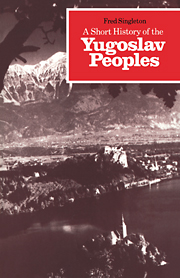Book contents
- Frontmatter
- Contents
- List of tables
- List of maps
- Preface
- Guide to pronunciation
- 1 The lands of the South Slavs
- 2 The early Slav settlers
- 3 The early Slav kingdoms
- 4 The South Slavs under foreign rule
- 5 The development of independence
- 6 The First World War
- 7 The kingdom of Serbs, Croats and Slovenes
- 8 The kingdom of Yugoslavia
- 9 Yugoslavia and the Second World War
- 10 The transition to socialism
- 11 The beginnings of self-management
- 12 The 1960s – a decade of reform
- 13 Tito's last ten years
- 14 Yugoslavia after Tito
- Bibliography
- Index
5 - The development of independence
Published online by Cambridge University Press: 20 February 2010
- Frontmatter
- Contents
- List of tables
- List of maps
- Preface
- Guide to pronunciation
- 1 The lands of the South Slavs
- 2 The early Slav settlers
- 3 The early Slav kingdoms
- 4 The South Slavs under foreign rule
- 5 The development of independence
- 6 The First World War
- 7 The kingdom of Serbs, Croats and Slovenes
- 8 The kingdom of Yugoslavia
- 9 Yugoslavia and the Second World War
- 10 The transition to socialism
- 11 The beginnings of self-management
- 12 The 1960s – a decade of reform
- 13 Tito's last ten years
- 14 Yugoslavia after Tito
- Bibliography
- Index
Summary
The Serbian revolts
The century following the Peace of Carlowitz (Karlovci) between the Habsburgs and the Turks in 1699 saw many changes in the relations among the European powers, some of which directly affected the South Slav peoples, and others which had delayed and indirect effects on them, the significance of which did not become apparent until well into the nineteenth century.
The most obvious direct result of the treaty was the repossession by the Habsburgs of Hungary, Transylvania and the Turkish occupied areas of Slavonia and Croatia. In 1718, by the Treaty of Passarowitz (Požarevac), the Banat, Little Wallachia, Belgrade and the Serbian regions of Šumadija, Posavina and Mačva were ceded by Turkey. These last three territories lay south of the Sava-Danube line and represented the first Habsburg advance across that symbolic divide since the catastrophe of Mohács in 1526. A Turkish recovery twenty years later re-established Ottoman control south of the line (Treaty of Belgrade, 1739), but the Habsburgs remained in the Vojvodina, Croatia and Slavonia. The Turks never again crossed the Danube-Sava line. In 1791, by the Treaty of Sistova, Belgrade was restored to Turkey, briefly reoccupied by Austria in 1789–92, and was not formally surrendered until the last Turkish garrison withdrew in 1867, although effective Turkish control had ceased some fifty years earlier.
The expulsion of the Turks from Vojvodina gave an opportunity for the Serbs of that area, many of whom were descendants of the refugees who had fled across the Danube in front of the advancing Ottomans during the previous two or three centuries, to develop their national culture in a freer atmosphere than had existed under Islamic rule.
- Type
- Chapter
- Information
- A Short History of the Yugoslav Peoples , pp. 72 - 113Publisher: Cambridge University PressPrint publication year: 1985



